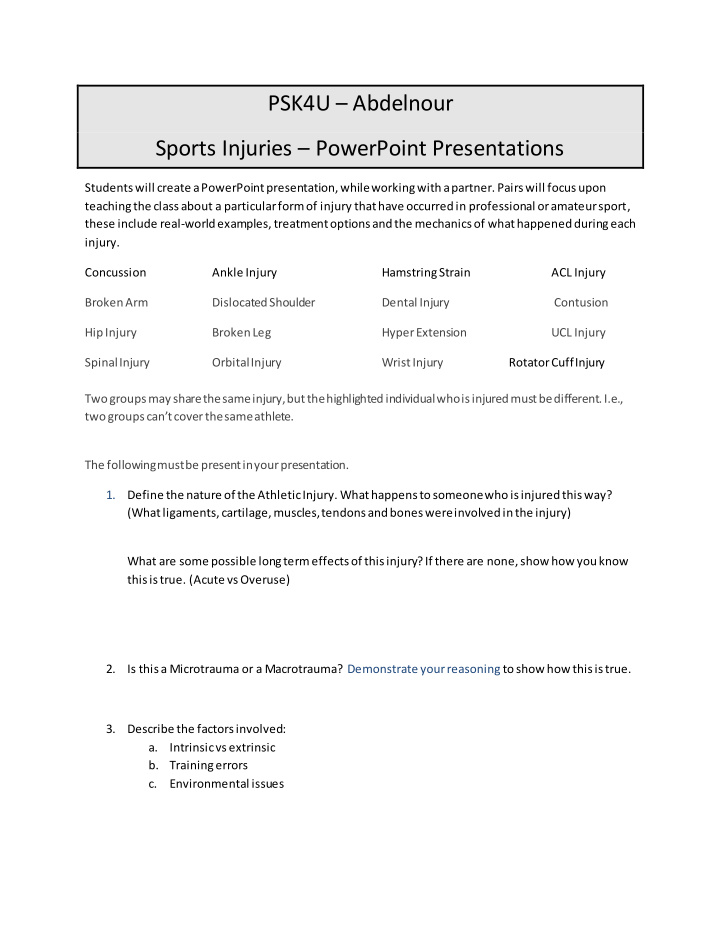



PSK4U – Abdelnour Sports Injuries – PowerPoint Presentations Students will create a PowerPoint presentation, while working with a partner. Pairs will focus upon teaching the class about a particular form of injury that have occurred in professional or amateur sport, these include real-world examples, treatment options and the mechanics of what happened during each injury. Concussion Ankle Injury Hamstring Strain ACL Injury Broken Arm Dislocated Shoulder Dental Injury Contusion Hip Injury Broken Leg Hyper Extension UCL Injury Spinal Injury Orbital Injury Wrist Injury Rotator Cuff Injury Two groups may share the same injury, but the highlighted individual who is injured must be different. I.e., two groups can’t cover the same athlete. The following must be present in your presentation. 1. Define the nature of the Athletic Injury. What happens to someone who is injured this way? (What ligaments, cartilage, muscles, tendons and bones were involved in the injury) What are some possible long term effects of this injury? If there are none, show how you know this is true. (Acute vs Overuse) 2. Is this a Microtrauma or a Macrotrauma? Demonstrate your reasoning to show how this is true. 3. Describe the factors involved: a. Intrinsic vs extrinsic b. Training errors c. Environmental issues
4. Types of Injuries a. Strain b. Sprain c. Contusion vs Fracture d. Tear e. Rupture f. Dislocation 5. Classification of Injury – Grades 1, 2, or 3. Show how you know this is true. 6. Create a Treatment and Recovery Plan for the athlete. (Look at methods of rehab (ex. Physio, athletic therapy, massage, surgery) 7. Find a video or series of still images that show what happened to the athlete or a video that discusses/explains/diagnoses the injury. During the presentation, explain what happened. Warning: graphic images will likely be in your future Family Guy (2000) References McFarlane, S. (25 July 2000). Family Guy . S02, E20. Fuzzy Door Productions.
Assessment Criteria Strand Does not meet Level 1 Level 1 Level 2 Level 3 Level 4 Knowledge & Required content not Presentation covers Presentation covers Presentation covers all Covers all required Understanding covered in this presentation, content areas with content areas. required content areas. content. Information is or was inaccurate or off inaccuracies and a lack Inaccurate information accurate, insightful and topic. of thoroughness. is minimal. shows connection to further learning. Thinking & Research is not apparent or Research shows limited Research shows some Research shows Research shows great does not related to the understanding of the understanding of the understanding of the understanding of the Inquiry injury. injury. injury. injury injury and extends research to related issues. Citations not provided. Citations provided but Citations provided with Citations provided with Diverse and adequate not compliant with APA some adherence to APA attention to APA list of sources cited in formatting rules. formatting rules. formatting rules. adherence to APA formatting rules. Application No rehabilitation procedure, Created inappropriate Basic knowledge of the Rehabilitation process Rehabilitation process exercises and method of rehabilitation rehabilitation process for the specific injury for the specific injury therapy provided. procedures, exercises but did not go into includes general includes specific and methods of therapy specifics about the exercises and general exercises and specific for the specific injury. rehabilitation of that method(s) of therapy method(s)s of therapy injury. showing a deeper insight for the injury and associated treatment options Communication Does not use correct Rarely uses correct Sometimes uses correct Often uses correct Always or almost anatomical terminology anatomical terminology anatomical terminology anatomical terminology always uses correct anatomical terminology PowerPpoint is used in a PowerPoint is used to PowerPoint is used to PowerPoint is used to PowerPoint is used to way that doesn’t clearly present information present information present information present information present information or with limited with some effectiveness effectively with great effectiveness address audience effectiveness and engages audience
Recommend
More recommend